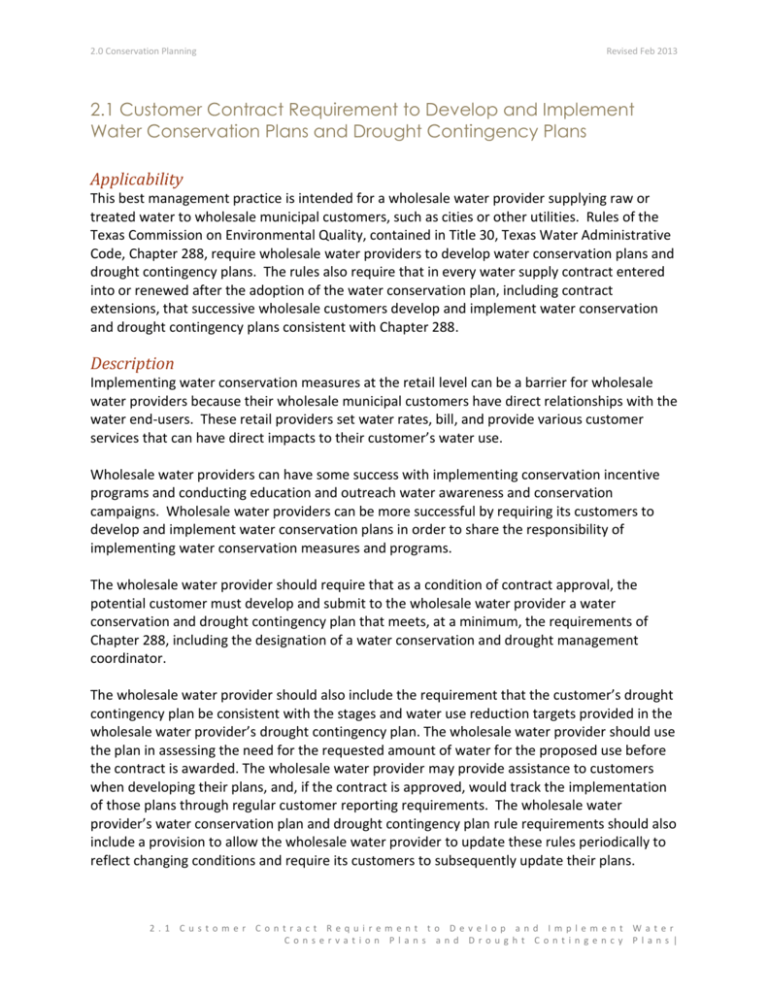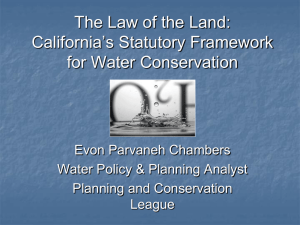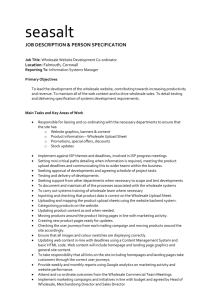Final Draft - Save Texas Water
advertisement

2.0 Conservation Planning Revised Feb 2013 2.1 Customer Contract Requirement to Develop and Implement Water Conservation Plans and Drought Contingency Plans Applicability This best management practice is intended for a wholesale water provider supplying raw or treated water to wholesale municipal customers, such as cities or other utilities. Rules of the Texas Commission on Environmental Quality, contained in Title 30, Texas Water Administrative Code, Chapter 288, require wholesale water providers to develop water conservation plans and drought contingency plans. The rules also require that in every water supply contract entered into or renewed after the adoption of the water conservation plan, including contract extensions, that successive wholesale customers develop and implement water conservation and drought contingency plans consistent with Chapter 288. Description Implementing water conservation measures at the retail level can be a barrier for wholesale water providers because their wholesale municipal customers have direct relationships with the water end-users. These retail providers set water rates, bill, and provide various customer services that can have direct impacts to their customer’s water use. Wholesale water providers can have some success with implementing conservation incentive programs and conducting education and outreach water awareness and conservation campaigns. Wholesale water providers can be more successful by requiring its customers to develop and implement water conservation plans in order to share the responsibility of implementing water conservation measures and programs. The wholesale water provider should require that as a condition of contract approval, the potential customer must develop and submit to the wholesale water provider a water conservation and drought contingency plan that meets, at a minimum, the requirements of Chapter 288, including the designation of a water conservation and drought management coordinator. The wholesale water provider should also include the requirement that the customer’s drought contingency plan be consistent with the stages and water use reduction targets provided in the wholesale water provider’s drought contingency plan. The wholesale water provider should use the plan in assessing the need for the requested amount of water for the proposed use before the contract is awarded. The wholesale water provider may provide assistance to customers when developing their plans, and, if the contract is approved, would track the implementation of those plans through regular customer reporting requirements. The wholesale water provider’s water conservation plan and drought contingency plan rule requirements should also include a provision to allow the wholesale water provider to update these rules periodically to reflect changing conditions and require its customers to subsequently update their plans. 2.1 Customer Contract Requirement to Develop and Implement Water Conservation Plans and Drought Contingency Plans| 2.0 Conservation Planning Revised Feb 2013 Implementation Depending on the size of its customer base, the wholesale water provider should have dedicated staff resources or other qualified contracted resources to review water conservation plans and drought contingency plans for the requirements of Chapter 288 rules and wholesale water provider rule sufficiency, and to provide technical assistance on water conservation and drought contingency plan development, as needed. Adequate wholesale water provider staff and other resources should also be available to track implementation of the plans. A wholesale customer water conservation and drought management coordinator is suggested to establish consistent, reliable communication with retail providers over time. The wholesale water provider should also develop rules for wholesale customer water conservation plans and drought contingency plans that: 1. Determine customer applicability requirements. For example, customers that use less than 10 acre-feet or temporary contracts may not need to develop specific plans. However, a condition in the water contract should include that water used under the contract shall be beneficially used for the authorized purpose without waste. Although required only through the contracting process, the wholesale water provider should encourage the development of water conservation plans and drought contingency plans by current customers. 2. Contain specific criteria for the determination of what constitutes an emergency water shortage, the process for customer notification, and procedures for the implementation of the pro rata reduction of water supply to wholesale water customers. In accordance with Texas Water Code §11.039 the wholesale water provider develops the draft rules, based on the Texas Commission on Environmental Quality’s Chapter 288 rules, researches for what is cost effective and acceptable to the customers, and if the wholesale water provider can legally adopt a specific measure included in the rule. 3. Consider adding additional requirements for contracts with either a volume or number of connections above a certain threshold level. 4. Consider including additional measures not in Chapter 288 rules, such as requiring limits on daytime irrigation and day of week watering, and adoption of state landscape irrigation standards. 5. Require customers to identify a conservation coordinator that is responsible for plan implementation and reporting to the wholesale water provider on progress. This individual is a point of contact responsible for plan implementation and reporting, not necessarily a dedicated staff person for conservation. 6. Require customers to provide yearly updates on plan implementation progress. 7. Consider including additional measures not in the 288 rules, such as setting a landscape water limit to no more than twice per week under the first stage of mandatory restrictions. More severe restrictions may be appropriate depending on local conditions. 8. Require triggers and response measures for reduction in water supply (not just water 2.1 Customer Contract Requirement to Develop and Implement Water Conservation Plans and Drought Contingency Plans| 2.0 Conservation Planning Revised Feb 2013 treatment capacity). Water supply triggers should be consistent between the wholesale water provider and the customer for the water supply that is managed by the wholesale water provider. Triggers for alternative water supplies should be addressed separately as additional requirements for initiation of drought response. 9. Require that the customer’s quantified water use reduction targets are consistent with the wholesale water provider’s drought contingency plan. 10. Consider development of sample drought contingency plans that can be adopted by customers. a. Require both plans to be approved by the wholesale water provider before a customer’s contract is signed. b. Consider developing and adopting penalties for non-compliance. c. Review rules for consistency with other wholesale water provider policies, plans/or rules such as other water resource, contracting, and customer service and legal policies. 11. Gather customer input: a. The rules are provided to the wholesale water provider customers and a mechanism is established to receive customer feedback. b. At a minimum, the draft rules should be provided to the customers (via mail, email, or some other media) and a meeting scheduled to discuss and receive input on the draft rules. c. Wholesale water provider considers customer feedback when the developing the final version of the rules. 12. Adopt rules and implement: a. Rules approved by wholesale water provider official governing body (Board/Council). b. Notify customers of new rules. c. Consider developing sample plans that can be considered and modified by customers. d. Begin implementation with new or amended water contracts within time period identified by rules or governing body. e. Develop a tracking tool that includes customer plan summaries and plan implementation. The tracking tool could compliment the state’s reporting tool, providing additional information that is not required by the state for those customers that must also report to the state. f. Wholesale water provider staff begins process of reviewing and approving plans prior to contract approval. g. Through staff technical assistance, promote adoption of additional water conservation measures such as: fixture replacement programs, ordinance or deed restrictions requiring landscape irrigation standards, and soil depth requirements. Scope and Schedule Development and adoption of this best management practice should be completed in a sixmonth period. Implementation of the practice should begin within an additional six-month period. Once implementation begins, the practice should be reviewed and modified a minimum of every five years. The suggested timeline for this practice includes: 2.1 Customer Contract Requirement to Develop and Implement Water Conservation Plans and Drought Contingency Plans| 2.0 Conservation Planning Revised Feb 2013 1. Develop draft rules. (two months) 2. Gather customer input. (two months) 3. Revise rules based on customer input. Wholesale water provider official governing body (Board/Council) approves rules. (two months) 4. Begin implementation with new or amended water contracts. (three to six months after official adoption) 5. Implementation reporting of conservation plans should be required annually. Alternately, they can be required every five years submitted in the year before the wholesale water provider is required to submit an updated water conservation plan and drought contingency plan to the Texas Water Development Board. 6. Best management practice is considered complete with or without penalties for noncompliance. Measuring Implementation and Determining Water Savings Measurements for best management practices implementation can be developed through creating a tracking database that includes specific plan elements. Customers are surveyed yearly to determine if plans are being implemented. Cost–benefit tracking tools such as the Alliance for Water Efficiency tracking tool can be used to determine water savings, if reliable savings estimates are available for a particular measure. The measures can be organized in the water savings tracking tool by wholesale water provider customer, so that the savings can also be provided to the customer for their own reporting of water savings. Cost-Effectiveness Considerations The direct cost of implementing this best management practice is primarily associated with the staff time for customer meetings to provide technical assistance with development and review of each plan. The total amount of staff time will depend on the number of customers requesting new or amended contracts. Additional labor costs include time spent tracking and reporting on implementing the customer’s plans. This best management practice can complement other practices implemented by the wholesale water provider (such as cost-share or outreach programs) as well as customer programs (many of those practices are included in the municipal best management practice section). Determination of the Impact on Other Resources By requiring its customers to develop and implement water conservation plans, the wholesale water provider is able to share the responsibility of conserving water for the wholesale water provider’s water basin service area, meet demand reduction goals during a drought, and ensure compliance with its water supply contracts. The data gathered and tracked can be used to project yearly and future conservation savings to the state and to the wholesale water provider governing body. Customers with drought contingency plans are also more effectively and 2.1 Customer Contract Requirement to Develop and Implement Water Conservation Plans and Drought Contingency Plans| 2.0 Conservation Planning Revised Feb 2013 quickly able to respond to the wholesale water provider’s request to implement water restrictions during droughts. References for Additional Information o o o o o Texas Administrative Code, Title 30, Chapter 288 Texas Water Development Board Best Management Practices Guide Lower Colorado River Authority, Administrative Rules for Water Sales Contracts Alliance for Water Efficiency California Urban Water Conservation Council Acknowledgments o Lower Colorado River Authority o Texas Commission on Environmental Quality o Texas Water Development Board 2.1 Customer Contract Requirement to Develop and Implement Water Conservation Plans and Drought Contingency Plans|









